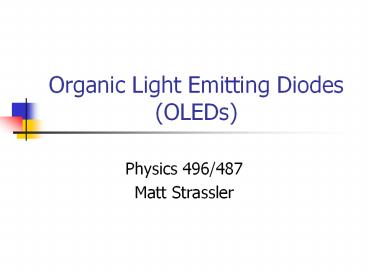Organic Light Emitting Diodes OLEDs PowerPoint PPT Presentation
1 / 22
Title: Organic Light Emitting Diodes OLEDs
1
Organic Light Emitting Diodes(OLEDs)
- Physics 496/487
- Matt Strassler
2
Why OLEDs
- Lighting efficiency
- Incandescent bulbs are inefficient
- Fluorescent bulbs give off ugly light
- LEDs (ordinary light emitting diodes) are bright
points not versatile - OLEDs may be better on all counts
- Displays Significant advantages over liquid
crystals - Faster
- Brighter
- Lower power
- Cost and design
- LEDs are crystals LCDs are highly structured
OLEDs are not - Malleable can be bent, rolled up, etc.
- Easier to fabricate
- In general, OLED research proceeds on many fronts
3
Plan of talk
- Light-Emitting Diode
- Bands and Conduction
- Semiconductor
- Standard Diode
- Light Emission
- Organic Light-Emitting Diode
- Organic Semiconductors
- Organic Diode
- Light Emission
4
Electrons in a Lattice
E
V(r)
- Atom has bound states
- Discrete energy levels
- Partially filled by electrons
- Periodic array of atoms (cf. QM textbook)
- Effectively continuous bands of energy levels
- Also partially filled
r
E
V(x)
r
5
The Bands on Stage
E
E
E
E
E
No Gap
Small Gap
Gap
Insulator
Conductor
Semiconductor
Doped Semiconductors
6
Doping Add Impurities
N-type
P-type
7
The Bands on Stage
E
E
E
E
E
N-type
P-type
No Gap
Small Gap
Gap
Insulator
Conductor
Semiconductor
Doped Semiconductors
8
Diode p-type meets n-type
E
E
9
Diode p-type meets n-type
E
E
10
Diode p-type meets n-type
E
E
11
Diode p-type meets n-type
E
E
Electric Field
Excess Positive Ions
Excess Negative Ions
12
Diode p-type meets n-type
Try to make current flow to left? Depletion Zone
Grows
Electric Field
13
Diode p-type meets n-type
Try to make current flow to right? Current
Flows! Electrons in higher band meet Holes in
lower band
Electric Field
Current
14
Excitons
N-type
- Electron in higher band meets a hole in lower
band - The two form a hydrogen-like bound state!
Exciton! - Like positronium
- Can have any orbital angular momentum
- Can have spin 0 or spin 1
- Annihilation
- Rate is slow
- Electron falls into hole
- Energy emitted
- Energy released as electron falls into hole
- May turn into vibrations of lattice (phonons)
heat - May turn into photons (only in some materials)
- Infrared light (if gap 1 eV) remote control
- Visible light (if gap 2-3 eV) LED
- May excite other molecules in the material (if
any see below)
E
15
Organic Semiconductors
- These are not crystals! Not periodic structures
- Band structure is somewhat different
- Orbitals determined by shape of organic
molecule - Quantum chemistry of pi bonds, not simple junior
QM - Polymers are common
- Conduction is different
- Electrons or holes may wander along a polymer
chain - As with inorganic conductors
- Some materials allow electrons to move
- Some materials allow holes to move typical for
organics!! - Doping is more difficult
- Doping typically not used
- Instead electrons/holes are provided by attached
metals
16
The basic OLED
Anode
Cathode
Conductive Layer
Emissive Layer
17
The basic OLED
- The holes move more efficiently in organics
Anode
Cathode
Conductive Layer
Emissive Layer
18
The basic OLED
- The holes move more efficiently in organics
- Excitons begin to form in emissive layer
Anode
Cathode
Conductive Layer
Emissive Layer
19
The Exciton Exits in a Flash
- As before, excitons eventually annihilate into
- Molecular vibrations ? heat (typical)
- Photons (special materials, rare)
- But with organics, can add
- Fluorescent molecules
- Phosphorescent molecules
- e.g. attach to end of polymer
- Light can be generated indirectly
- Exciton can transfer its energy to this molecule
- Molecule is thus excited
- Returns to ground state via fluorescence or
phosphorescence - Greatly increases likelihood (per exciton) of
light emission - Also allows for different colors
- determined by the light-emitting molecule(s), not
the exciton
20
OLEDs
- Similar physics to LEDs but
- Non-crystalline
- No doping use cathode/anode to provide needed
charges - Fluorescence/phosphorescence enhance
exciton?light probability - Manufacturing advantages
- Soft materials very malleable
- Easily grown
- Very thin layers sufficient
- Many materials to choose from
- Relatively easy to play tricks
- To increase efficiency
- To generate desired colors
- To lower cost
- Versatile materials for future technology
21
Some references
- How Stuff Works
- http//electronics.howstuffworks.com
- Craig Freudenrich, How OLEDs work
- Tom Harris, How LEDs Work
- Hyperphysics Website
- http //hyperphysics.phy-astr.gsu.edu/hbase/solids
/pnjun.html - The P-N Junctions, by R Nave
- Connexions Website
- http//cnx.org
- The Diode, by Don Johnson
- Webster Howard, Better Displays with Organic
Films - Scientific American, pp 5-9, Feb 2004
- M.A. Baldo et al, Highly efficient
phosphorescent emission from organic
electroluminescent devices - Nature 395, 151-154 (10 September 1998)
- Various Wikipedia articles, classes, etc.
22
A neat trick
- Exciton
- Spin 0 (singlet)
- Spin 1 (triplet)
- Can transfer its energy but not its spin to
molecule - Thus spin-1 cant excite fluorescents
- Lose ¾ of excitons
- But
- Use phosphors
- Bind to polymer so that exciton can transfer spin
- Then 4 times as many excitons cause light emission
P

